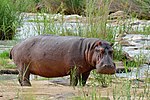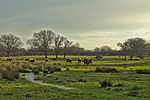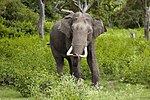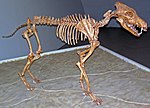Megaherbivores (Greek μέγας megas "large" and Latin herbivora "herbivore") are large herbivores that can exceed 1,000 kg (2,200 lb) in weight. The earliest...
46 KB (4,362 words) - 21:29, 31 August 2024
Wood-pasture hypothesis (redirect from Megaherbivore theory)
wood-pasture hypothesis (also known as the Vera hypothesis and the megaherbivore theory) is a scientific hypothesis positing that open and semi-open...
148 KB (16,131 words) - 14:54, 22 August 2024
semi-evergreen forests across the range. The species is classified as a megaherbivore and consume up to 150 kg (330 lb) of plant matter per day. They consume...
40 KB (4,326 words) - 22:03, 28 July 2024
This is a list of all nine extant species of megaherbivores, with a brief description for each. Elephants, rhinoceroses, hippopotamuses, and giraffes are...
12 KB (817 words) - 03:38, 1 March 2024
produces a large hard edible fruit which is accessible only to the megaherbivores in the wild like elephants. A study in the Buxa Tiger Reserve by ecologists...
5 KB (559 words) - 07:24, 13 June 2023
Turvey, Samuel T. (July 2021). "Simultaneous extinction of Madagascar's megaherbivores correlates with late Holocene human-caused landscape transformation"...
34 KB (3,426 words) - 12:22, 30 August 2024
vertebrates found in the area, and shared its habitat with other dinosaurian megaherbivores, as well as large theropods and crocodylomorphs. Remains thought to...
40 KB (4,570 words) - 09:14, 12 April 2024
Diceros bicornis: Information. (9 April 2009) Owen-Smith, R. Norman, Megaherbivores: The Influence of Very Large Body Size on Ecology. Cambridge University...
162 KB (16,262 words) - 01:50, 25 August 2024
Qureshi, Q. & Kalle, R. (2012). "Group size and population structure of megaherbivores (gaur Bos gaurus and Asian elephant Elephas maximus) in a deciduous...
59 KB (4,948 words) - 05:19, 23 August 2024
driven to extinction or even encountered by human. The hippopotamus is a megaherbivore and is exceeded in size among land animals only by elephants and some...
76 KB (8,446 words) - 18:32, 29 August 2024
Owen-Smith, Norman; Chafota, Jonas (28 June 2012). "Selective feeding by a megaherbivore, the African elephant (Loxodonta africana)". Journal of Mammalogy. 93...
60 KB (6,393 words) - 10:10, 27 August 2024
Derek E.; Ozgul, A.; König, B. (2019). "Fission–fusion dynamics of a megaherbivore are driven by ecological, anthropogenic, temporal, and social factors"...
124 KB (11,990 words) - 12:06, 16 July 2024
their large upper canines, they were adapted to prey on large-bodied megaherbivores. Miomachairodus is the oldest known member of this subfamily. Metailurus...
49 KB (3,902 words) - 22:22, 12 August 2024
rhino is a driving factor in its ecosystem. The destruction of the megaherbivore could have serious cascading effects on the ecosystem and harm other...
49 KB (5,338 words) - 20:59, 19 August 2024
than 15 kilograms (33 lb). Additionally, Owen-Smith coined the term megaherbivore to describe herbivores that weighed over 1,000 kilograms (2,200 lb)...
79 KB (8,071 words) - 16:24, 26 August 2024
individuals. Asian elephants are crepuscular. They are classified as megaherbivores and consume up to 150 kg (330 lb) of plant matter per day. Around 50...
105 KB (11,006 words) - 21:24, 31 August 2024
Depiction of the megaherbivores in the Dinosaur Park Formation, Styracosaurus third from left, with herd in the right background...
48 KB (5,288 words) - 15:58, 27 August 2024
characteristics are thought to be adaptations for preying on Late Pleistocene megaherbivores, and in North America, its prey is known to have included western horses...
108 KB (11,677 words) - 18:56, 11 July 2024
continentality hypotheses. Megaherbivores have prospered at other times of continental climate. For example, megaherbivores thrived in Pleistocene Siberia...
202 KB (19,725 words) - 22:09, 31 August 2024
occurred just before the transformation of the rangelands that supported megaherbivores into widespread wetlands that supported herbivore-resistant plants....
41 KB (4,484 words) - 05:21, 20 August 2024
direct and indirect effects of consumption and ecosystem engineering by megaherbivores". Ecology. 97 (11): 3219–3230. Bibcode:2016Ecol...97.3219C. doi:10.1002/ecy...
29 KB (3,186 words) - 06:46, 24 August 2024
Tiger Reserve. Such cases are rare, as Indian rhinoceroses—like most megaherbivores—are mostly invulnerable to predation. Indian rhinos are grazers. Their...
56 KB (6,092 words) - 12:39, 19 August 2024
Tibet: Pliocene Woolly Rhino Suggests High-Plateau Origin of Ice Age Megaherbivores". Science. 333 (6047): 1285–1288. Bibcode:2011Sci...333.1285D. doi:10...
10 KB (472 words) - 19:58, 8 July 2024
(Dinosauria, Sauropoda): testing hypotheses of feeding behavior in an extinct megaherbivore". Naturwissenschaften. 99 (8): 637–643. Bibcode:2012NW.....99..637Y...
89 KB (10,063 words) - 00:52, 28 August 2024
(2021). "The ghost of a giant – Six hypotheses for how an extinct megaherbivore structured kelp forests across the North Pacific Rim". Global Ecology...
69 KB (7,410 words) - 18:56, 28 August 2024
Edmontosaurs (Dinosauria: Hadrosauridae): Implications for Latest Cretaceous Megaherbivore Diversity in North America". PLOS ONE. 6 (9): e25186. Bibcode:2011PLoSO...
95 KB (9,993 words) - 16:19, 27 August 2024
March 1997 Owen-Smith, N. Pleistocene extinctions; the pivotal role of megaherbivores. Paleobiology; July 1987; v. 13; no. 3; p. 351-362 P. Brinck. The Relations...
33 KB (3,728 words) - 08:15, 30 August 2024
1080/08912963.2017.1383987. S2CID 90015342. Owen-Smith, R.N. (1992). Megaherbivores: The influence of very large body size on ecology. Cambridge studies...
82 KB (9,292 words) - 22:53, 22 August 2024
With the arrival of the paleoindians and the disappearance of the megaherbivores, grazing pressure was maintained by deer and elk, and then by the grazing...
12 KB (843 words) - 02:56, 27 July 2024
Tibet: Pliocene woolly rhino suggests high-plateau origin of Ice Age megaherbivores". Science. 333 (6047): 1285–1288. Bibcode:2011Sci...333.1285D. doi:10...
46 KB (4,247 words) - 12:48, 26 June 2024




























